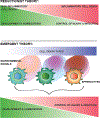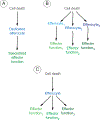Determining the effector response to cell death
- PMID: 33188303
- PMCID: PMC8102327
- DOI: 10.1038/s41577-020-00456-0
Determining the effector response to cell death
Abstract
Cell death occurs when a pathogen invades a host organism or the organism is subjected to sterile injury. Thus, cell death is often closely associated with the induction of an immune response. Furthermore, cell death can occur as a consequence of the immune response and precedes the tissue renewal and repair responses that are initiated by innate immune cells during resolution of an immune response. Beyond immunity, cell death is required for development, morphogenesis and homeostasis. How can such a ubiquitous event as cell death trigger such a wide range of context-specific effector responses? Dying cells are sensed by innate immune cells using specialized receptors and phagocytosed through a process termed efferocytosis. Here, we outline a general principle whereby signals within the dead cell as well as the environment are integrated by specific efferocytes to define the appropriate effector response.
Conflict of interest statement
Competing interests
The authors declare no competing interests.
Figures




References
-
- Lowin B, Peitsch MC & Tschopp J Perforin and granzymes: crucial effector molecules in cytolytic T lymphocyte and natural killer cell-mediated cytotoxicity. Curr. Top. Microbiol. Immunol 198, 1–24, (1995). - PubMed
-
- Gordon S The macrophage: past, present and future. Eur. J. Immunol 37 Suppl 1, S9–17, (2007). - PubMed
-
- Ahmed R & Gray D Immunological memory and protective immunity: understanding their relation. Science 272, 54–60, (1996). - PubMed
-
- Swain SL et al. From naive to memory T cells. Immunol. Rev 150, 143–167, (1996). - PubMed
Publication types
MeSH terms
Substances
Grants and funding
LinkOut - more resources
Full Text Sources

